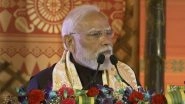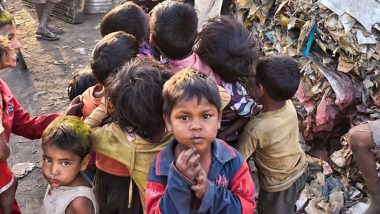New Delhi, March 19: From the detection of its first case to the development and execution of COVID-19 vaccination drive, the infectious virus created strong ripples in the global economy, whose spill over effects are still felt. As several countries slid into recession, owing to pandemic-induced lockdown, a global economic slowdown was inevitable. While efforts are being made to bring back economies on track, the detection of newer strains of coronavirus and suspicion about the vaccines pose a constant threat. India's Economy Projected to Record Stronger Recovery in 2021: UNCTAD.
A research conducted by US-based Pew Research Centre on India and China- both in the same geographic block and similar population levels- shows that the impact economic of COVID-19 outbreak and subsequent lockdown are more severe in the former, while smaller changes are recorded in the latter. The Indian economy, which as per World Bank's official data had a GDP of 5.8 per cent in 2020, saw a negative downturn with the growth being estimated at -9.6 per cent in January 2021. Meanwhile, China's GDP stood at 5.9 per cent in 2020, and for January 2021 it was estimated to be 2 per cent.
As per the research, the Indian poor (with daily income of $2 or less) have increased by 75 Million owing to the COVID-19 recession, accounting to nearly 60 per cent of the global increase in poverty. It also stated that the increase in participation of people in the rural employment programmmes can be attributed to the increased levels of poverty in the country. However, poverty was virtually unchanged in China, the report noted. India’s GDP Estimated To Grow 12.6% in Financial Year 2022 Making It the World’s Fastest-Growing Economy, Says OECD Interim Economic Outlook.
The report also pointed out that the Indian middle class (with daily income of $10.01- $20) is estimated to have shrunk by 32 Million in 2020 as a consequence of the downturn, accounting to 60 per cent of the global retreat of the middle -income people. Meanwhile, in China the number of people in the middle-income tier likely decreased by 10 Million.
The pandemic also impacted the living standards of people in both the countries, however the intensity differs. In India the number of people in the poor category have reached 134 million, more than double the 59 million expected before to the recession. As per the report, the poverty rate in India likely rose to 9.7 per cent in 2020, up sharply from the January 2020 forecast of 4.3 per cent. The situation remained comparatively modest in China with number of poor increasing from 3 Million to 4 Million during the time period.
The population in the low-income class in India, which was expected to be 1.20 Billion in 2020 has dropped to 1.16 Billion as the pandemic pushed more people into the poor category. As per research, it now accounts to 30 per cent of the global low-income population. Meanwhile, China witnessed a moderate expansion of the low-income class with an increase from 611 Million to 641 Million during the period.
However, the research noted that for both the countries, the drop in the living standards during 2020 have been large as compared by the previous trends. As per the report, "The retreat of India’s middle class in 2020 – by 32 million – also looms large in the context of the addition of 57 million to this income tier from 2011 to 2019." It added, "In China, there had been a sizable addition of 247 million people to the middle-income tier from 2011 to 2019. "
(The above story first appeared on LatestLY on Mar 19, 2021 09:31 AM IST. For more news and updates on politics, world, sports, entertainment and lifestyle, log on to our website latestly.com).













 Quickly
Quickly


